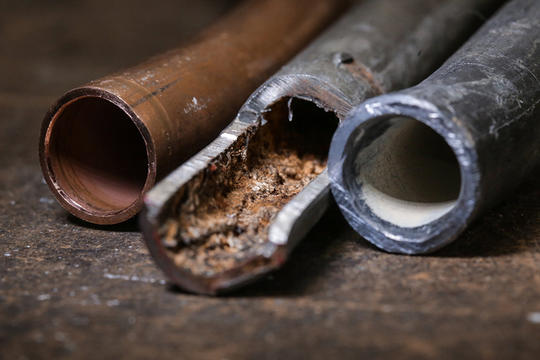As one of the earliest metals discovered by humans, lead has been used in many ways throughout history. One example was in the world of plumbing, where Romans took advantage of this soft metal with a low melting temperature to make lead water pipes. In fact, the Latin word “Plumbum” is the origin of the elemental symbol for lead of Pb. The ancient Romans also used lead in the kitchen for pots and kettles, and even as a flavor for cooking. It is said that lead has a sweet overtone, and it was thus used to enhance “one-fifth of the 450 recipes in the Roman Apician Cookbook”.1 After the collapse of the Roman Empire, lead continued to be widely use during Medieval times, in items such as cisterns, coffins, gutters, and roofing. The metal was useful because its low melting temperature made it easier to extract, it did not corrode easily, and its malleability allowed it to be shaped into many different forms. According to the International Lead Association (ILA), today’s lead uses are focused on “power and protection” which includes things such as “radiation protection, underwater power and communication cables, vehicle batteries, electric vehicle batteries and in batteries operating emergency power supplies”.2

It is clear that the metal plays an important role in our economy, and affords necessary tools that are needed worldwide. China is the world’s top lead producer and a leading exporter, with peak production of 5.32 million metric tons in 2012 (see Figure 1).3
According to Future Market Insights, “the global market for lead has been witnessing noticeable growth on account of growing lead-acid battery consumption”, and, “growth of the building construction industry is anticipated to be one of the major factors driving the demand for lead over the next few years”.4 The uses of lead appear limitless, and likely will continue to expand with advancing technologies and increased demand. However, the positive economic impacts associated with new applications of lead in key technologies may be offset by the negative consequences of significant adverse health impacts associated with lead.

In the 21st century, lead is still widely used in many traditional forms including paints, children’s toys, and water pipes. These in-home applications can affect family health, especially for children. Lead paint was banned in the United States in 1978, but the presence of the paint in older homes still threatens millions around the country (see Figure 2). Children’s toys may also contain traces of lead paint; lead water pipes corrode and leach lead into water systems, causing another immediate health concern. The EPA states, “Lead pipes are more likely to be found in older cities and homes built before 1986”.5 Although uncommon in modern cities because of lead pipe bans enacted in the 1970s, pipes may be switched or interconnected to other older systems, or they may be corroded by improper treatment. Evidently, we all may be getting poisoned within our own homes and might not even know it. because of the potential presence of lead in paint, toys, and pipes among other household objects.
For decades, the ILA has contributed to this public health crisis, and the toll it has taken on the impoverished and/or black, indigenous, people of color (BIPOC) in the United States. Historically, the ILA has promoted lead for use in water piping as opposed to other metals. They have even published “practical advice on the installation and repair of lead pipes” and have worked to convince “plumbers’ organizations, local water authorities, architects, and federal officials” to use lead pipes.6 The ILA campaign is taking a toll on public health; a prominent example is the ongoing water crisis in Flint, Michigan, where a series of cost-saving decisions resulted in a city of more than 95,000 people being exposed to high levels of lead.

The Flint water crisis clearly demonstrates the reasons to remove lead pipes in water systems. When the city made the switch in 2014 from Detroit’s water system to the Flint River as a primary water source to save money, officials claimed that the water was safe to drink.7 City utilities, however, did not treat the water to prevent possible pipe corrosion that could happen from the new water source, and this evolved quickly into a public health crisis. Within weeks, thousands of people reported foul-smelling and tasting water in regular home appliances. The contamination escalated and tapwater in a number of homes was brown in color, indicating significant problems (see Figure 4). Despite this, the Michigan Depart of Environmental Quality (MDEQ) quickly assured people that the water was fine and even omitted water lead reports from the government which would remove any possible federal action. Pell and Schneyer from Reuters stated, “In the year after Flint switched to corrosive river water that leached lead from old pipes, 5 percent of the children screened there had high blood lead levels”.8

As the threat of living with lead is all too real, it is important to be aware of the possible adverse health effects. Exposure to lead may be acute or chronic, but it especially affects children, who are more vulnerable to toxicity. Acute exposure to lead happens from a sudden exposure, while chronic exposure develops over a period of time. Children exposed to lead may present with brain damage, learning and behavioral changes, and stunted growth. As grown ups, presented health effects may then include: headaches, memory loss, high blood pressure, kidney disease, and joint pain (see Figure 3).
Ms. Tamara Rubin, of the Lead Safe America Foundation, is an advocate for reducing childhood lead poisoning, and educates others with a documentary titled, “MisLEAD: America’s Secret Epidemic”.9 Ms. Rubin’s efforts to prevent childhood lead exposure started in the home she lived in with her own children. Two of Ms. Rubin’s sons were poisoned by lead when a painting contractor failed to use lead-safe work practices when working on the exterior of her family’s historic home. From there she learned as much as she could about lead poisoning and started the Lead Safe America Foundation to raise awareness about the danger of childhood lead poisoning.10 The issue of childhood lead poisoning is a serious health crisis, with potentially millions exposed worldwide to lead in their own homes. With lead present in older (pre-1986) in paints and in water lines, it must be taken into consideration that those living in older cities and homes are more susceptible to exposure. The socioeconomic implications of these exposure paths are that people of color and people in poverty (both of which may often go hand-in-hand) may be more exposed by living in older lead-filled homes.
The 95,000+ people in Flint, a majority-black city with poverty rates approaching 40 percent, would later see officials from the MDEQ and other state agencies be criminally charged.11 The Flint water crisis has continued for more than five years, and identification and replacement of lead-containing water supply continues slowly. On August 13, 2020 the mayor of Flint announced that 91% of household pipe inspections were completed. The replacement of lead pipes with copper pipes has been performed in thousands of homes and water lines, with a final completion deadline set for November 30th, 2020.12 The exposure of thousands of people through home water lines encourages us to ask if lead is a necessary resource, or a disaster waiting to happen. However, addressing a crisis Flint, Michigan does not mean that the crisis as a whole is over. Many homes all across the nation are still using lead pipes to carry water throughout their homes even after 30 years of the ban of lead piping.13
Lead is a problem backed by an industry that continues to promote it. While the metal is clearly recognized as a toxic risk, the concern with poisoning is something ILA would rather try to work around. An ILA report titled, Health Issues for Lead Workers and the General Population, discusses health issues related to the use of lead. At best, the acknowledgement by ILA of health issues such as impairment of the central nervous system, and kidney and heart damage, while continuing to support the use of lead, sends an inconsistent message with respect to the potential threat to public health.14
However, many people are aware of the problems that this imposes and are trying to help. As an advocate for reducing the exposure of children to lead, Tamara Rubin says there is only one culprit to people being lead poisoned and it is the lead industry itself.15 The Lead Safe America Foundation, has three main goals: emergency intervention and support for children who have been poisoned as the result of acute or chronic exposure; outreach, intervention and education to prevent childhood lead poisoning; and parent-advocate support. There are many efforts alongside the Lead Safe America Foundation that are focused on the use of lead in our everyday environment. These groups are bringing awareness to the dangers of lead in many ways. National Lead Poisoning Prevention week (October 25-31 this year) is dedicated specifically to raising awareness of lead poisoning.16 By engaging with the Lead Safe America Foundation and taking part in events such as National Lead Poisoning Prevention week, the problem of environmental lead exposure can be more widely recognized. With continued efforts to educate about the risks associated with lead, the incidences of lead poisoning will perhaps begin to diminish.
Lead is a useful metal, but at the same time is toxic to human health and should not be used in such close proximity to our families. Removal of lead from our environment, however, is not likely to be easy or inexpensive – Flint, Michigan fought for 6 years to evaluate and replace the lines that carried water to their homes. The problem with lead in Flint may nearing its end, but the public health crisis of lead may just very well be beginning.
- Lewis, J. EPA Web Archives (US) (EPA). Lead Poisoning: A Historical Perspective. 1985 (accessed 2020 Nov 17). 1 p. Available from: https://archive.epa.gov/epa/aboutepa/lead-poisoning-historical-perspective.html. ↵
- International Lead Association. History of Lead. 2020 (accessed 2020 Oct 27). https://www.ila-lead.org/lead-facts/history-of-lead. ↵
- Mudd, G. Annual Lead Production (Mt Pb) (graph). Clayton, Australia: Ore Geology Reviews. 2016 (accessed 2020 Oct 10). http://www.thesustainabilitysociety.org.nz/conference/2010/papers/Mudd.pdf. ↵
- Future Market Insights. Market Overview. Lead Market. 2020 (accessed 2020 Nov 6). https://www.futuremarketinsights.com/reports/global-lead-market. ↵
- Office of Chemical Safety and Pollution Prevention, United States Environmental Protection Agency (US) (EPA). Learn about lead. Lead. 2013 (accessed 2020 Oct 10). 1 p. Available from: https://www.epa.gov/lead/learn-about-lead#main-content. ↵
- Rabin, R. The lead industry and lead water pipes “A Modest Campaign”. American journal of public health. 2008 (accessed 2020 Oct 27); 1584-92. https://www.ncbi.nlm.nih.gov/pmc/articles/PMC2509614/. ↵
- Ruckart, P. et al. The Flint Water Crisis: A Coordinated Public Health Emergency Response and Recovery Initiative. Journal Public Health Management and Practice. Jan/Feb 2019 (accessed 2020 Nov 17). https://www.ncbi.nlm.nih.gov/pmc/articles/PMC6309965/. ↵
- Schneyer J, Pell MB. Thousands of U.S. Areas Afflicted with Lead Poisoning beyond Flint’s. 2016 Dec 19 (accessed 2020 Oct 10). https://www.scientificamerican.com/article/thousands-of-u-s-areas-afflicted-with-lead-poisoning-beyond-flints/ ↵
- Zalokar, S. Lead poisoning has one culprit, advocate says: the lead industry. 2016 Apr 9 (accessed 2020 Oct 27). https://www.streetroots.org/news/2016/04/09/lead-poisoning-has-one-culprit-advocate-says-lead-industry ↵
- MacEachern D. Lead Safe America founder discusses childhood lead poisoning. Momscleanairforce.org. 2016 Apr 4 (accessed 2020 Nov 11). https://www.momscleanairforce.org/interview-tamara-rubin/ ↵
- Merrit, K. Lead-Laced Water in Flint: A Step-By-Step Look At The Makings Of A Crisis. 2016 Apr 20 (accessed 2020 Oct 27). https://www.npr.org/sections/thetwo-way/2016/04/20/465545378/lead-laced-water-in-flint-a-step-by-step-look-at-the-makings-of-a-crisis. ↵
- Callan, W. Flint mayor announces new deadline to replace lead water service lines. 2020 Aug 13 (accessed 2020 Oct 27). https://www.michiganradio.org/post/flint-mayor-announces-new-deadline-replace-lead-water-service-lines. ↵
- Rosenthal, L and Craft, W. Buried Lead. 2020 May 4 (accessed 2020 Oct 27). https://www.apmreports.org/story/2020/05/04/epa-lead-pipes-drinking-water#:~:text=Across%20the%20country%2C%20lead%20pipes,tens%20of%20millions%20of%20people ↵
- International Lead Association. Health Issues for Lead Workers and the General Population. 2020 (accessed 2020 Nov 6). https://www.ila-lead.org/UserFiles/File/Health%20Issues%20for%20Lead%20Workers%20and%20the%20General%20Population.pdf ↵
- Zalokar, S. Lead poisoning has one culprit, advocate says: the lead industry. 2016 Apr 9 (accessed 2020 Oct 27). https://www.streetroots.org/news/2016/04/09/lead-poisoning-has-one-culprit-advocate-says-lead-industry ↵
- National Center for Environmental Health, Centers for Disease Control and Prevention (US) (NIH). National Lead Poisoning Prevention Week. Childhood Lead Poisoning Prevention. 2020 (accessed 2020 Nov 6). 1 p. Available from: https://www.cdc.gov/nceh/lead/national-lead-poisoning-prevention-week.html ↵




54 comments
Alejandra Pardo
Great title! It is impressive that the use of lead is definitely limitless but comes with such a negative impact. The article is well composed and informative, It is sad to hear that although over time we have become more educated on the effects of lead, and continue to allow a crisis like Flint. The article does an amazing job informing and advocating for the use of lead and how it has affected people overall.
Alexis Zepeda
Hello! What an informative article! I am not too familiar with lead and water contamination. Honestly, the last I heard of such contamination was when the incident of Flint, Michigan first hit news outlets everywhere. I can appreciate the fact that lead was first used by the Romans. Personally, I did not know it was the Romans were the ones that began to use lead in water pipes for its natural properties. I also appreciated the explanation of multiple ways that lead is used, which inherently means other potential ways of harm. I have never known just exactly all the ways in which lead is used to create goods that we do not think twice about regarding danger. It is good to know there are people who are trying to fix the lead issues in water pipes.
Naya Harb
This article was a perfect example of the ethical differences some communities face. It has already been proven in the past that metal horribly affects health. The fact that lead and metals are still being used in “poor” neighborhoods is proof of carelessness to people with no money. Although metals and lead can be beneficial in other aspects, I believe that citizens’ health should always come first. Thank you for writing this article and bringing to light a very important issue that I hope can be fixed to provide better ways of living for everyone equally.
Aaron Onofre
This article was well written and it’s important to continue to address this ongoing issue of lead poisoning throughout the country. Flint, Michigan has definitely brought attention to this issue, and it shows how ignoring all the possible dangers of lead can lead to serious consequences for thousands. It is important that we protect our most vulnerable as well as our future, that future being the youth of this generation.
Jacqueline Galvan
This article enlightened me on a crisis that I had little information on that disproportionately affects people of color and their communities. The lead crisis is one that I was aware of, but not one that I thought was very prevalent, and this article did a great job of simplifying the dangers that come with the use of lead in homes.
Osondra Fournier-Colon
Seeing how much lead has impacted the world throughout the years is interesting, and there are still traces of it left in old homes. Due to its toxicity, the surprising revelation that leads is used in plumbing and kids’ toys even with the regulations set up is concerning. Good thing people are taking action to replace lead plumbing and reduce its presence in today’s modern world. It great and interesting article, love how in-depth it went.
Estefania Walther
This article was very informative and it cleared up some things I had always wondered about lead. Growing up, I would see certain ads or articles claiming that certain products had traces of lead and that you should stay clear from them. Now reading this and learning about lead pipes, that opens a whole new realm of endangerment. If that is what we use for plumbing we are exposing ourselves to lead poisoning. I think it’s great how these groups of people are trying to shed a light on this matter and how seriously we need to be taking it.
Sudura Zakir
This article is informative and detailed about how lead affects human health. Although it tastes sweet but dangerously unhealthy which affect human body. But Romans were using lead in food, utensils and so on without caring about health and consequences. How China took the place for lead and impacting everything which is not good sign. If we consider Pb as food or use it in regular basis it will led to high mortality rate. I enjoyed reading this whole article.
Olivia Flores
I remember hearing of the events happening in Flint Michigan with the lead issue and being astonished. It is crazy how much lead it used for and how toxic it can be. It is so simple to think that something like pipes can affect water and toxicity yet so complex to get rid of. It is great to advocate for the stopping of lead in so many things such as Childs toys as it can have long term affects. This article was valuable and insightful as it informs you not he lead crisis and proves information on how we can be more aware of the products we use every day.
Joseph Frausto
Interestingly, the ILA’s activism and work illustrates an interesting concept within the field of civic engagement. It seems common within seemingly positive social and civic movements for unintended, negative adverse Here, while the ILA is intended to be a positive group, promoting the lead industry and the jobs it supports in less developed nations. Still, this article does a great job of highlighting how this industry negatively impacts communities of color.